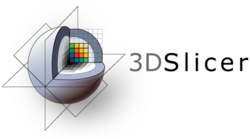Difference between revisions of "Training-3.4"
(New page: __NOTOC__ = Welcome to the 3D Slicer3.4 User Training 101= The information on this page applies to '''3D Slicer version 3'''. If you are looking for materials about Slicer version 2, pleas...) |
m (Text replacement - "\[http:\/\/www\.slicer\.org\/slicerWiki\/images\/([^ ]+) ([^]]+)]" to "[http://www.slicer.org/w/img_auth.php/$1 $2]") |
||
| (6 intermediate revisions by one other user not shown) | |||
| Line 1: | Line 1: | ||
__NOTOC__ | __NOTOC__ | ||
= Welcome to the 3D Slicer3.4 User Training 101= | = Welcome to the 3D Slicer3.4 User Training 101= | ||
| − | The information on this page applies to '''3D Slicer version 3'''. | + | The information on this page applies to '''3D Slicer version 3.4'''. Please visit the following links for training materials on [http://www.na-mic.org/Wiki/index.php/Slicer3.2:Training Slicer3.2] or [http://wiki.na-mic.org/Wiki/index.php/Slicer:Workshops:User_Training_101 Slicer2]. |
{| border="00" cellpadding="5" cellspacing="0" | {| border="00" cellpadding="5" cellspacing="0" | ||
| Line 14: | Line 14: | ||
*'''For questions about the materials on this page, please send an e-mail to Sonia Pujol, Ph.D. (spujol at bwh.harvard.edu)'''. | *'''For questions about the materials on this page, please send an e-mail to Sonia Pujol, Ph.D. (spujol at bwh.harvard.edu)'''. | ||
| − | | style="background: #e5e5ff" colspan="2" align="center"| <b>[http:// | + | | style="background: #e5e5ff" colspan="2" align="center"| <b>[http://wiki.na-mic.org/Wiki/index.php/Slicer3:Slicer3Brand Slicer Logo]</b> |
|- | |- | ||
| style="background: #e5e5ff"|[[Image:3DSlicerLogo-H-Color-424x236.png|center|250px|Slicer logo]] | | style="background: #e5e5ff"|[[Image:3DSlicerLogo-H-Color-424x236.png|center|250px|Slicer logo]] | ||
| Line 26: | Line 26: | ||
|- style="background:#b3b3e7; color:black" align="left" | |- style="background:#b3b3e7; color:black" align="left" | ||
| style="width:5%" | '''Category''' | | style="width:5%" | '''Category''' | ||
| − | | style="width: | + | | style="width:40%" | '''Tutorial''' |
| − | | style="width: | + | | style="width:40%" | '''Sample Data''' |
| − | | style="width: | + | | style="width:15%" | '''Image''' |
|- | |- | ||
| style="background:#e5e5ff; color:black" align="Center"| '''1.1''' | | style="background:#e5e5ff; color:black" align="Center"| '''1.1''' | ||
| − | | style="background:#e5e5ff; color:black"| | + | | style="background:#e5e5ff; color:black"| [[Media:3DVisualization_SoniaPujol_Munich2008_2.ppt| Data Loading and 3D Visualization in Slicer3 ]] |
| + | | style="background:#e5e5ff; color:black"| [http://www.na-mic.org/Wiki/index.php/Image:SlicerSampleVisualization.tar.gz Slicer3 Visualization Sample Data] (.tar.gz) <br> [http://www.na-mic.org/Wiki/index.php/media:SlicerSampleVisualization.zip Slicer3 Visualization Sample Data] (.zip) | ||
| + | | style="background:#e5e5ff; color:black" align="Center"| [[Image:SceneRestore.png|200px|LoadingandVisualization]] | ||
| + | |- | ||
| + | | style="background:#e5e5ff; color:black" align="Center"| '''1.2''' | ||
| + | | style="background:#e5e5ff; color:black"| [[Media:Manual Segmentation with 3DSlicer-mj.ppt| Manual segmentation with 3D Slicer]] | ||
| style="background:#e5e5ff; color:black"| | | style="background:#e5e5ff; color:black"| | ||
| − | | style="background:#e5e5ff; color:black" align="Center"| | + | | style="background:#e5e5ff; color:black" align="Center"| [[Image:OrbitSegmentationt.png|200px]] |
|- | |- | ||
| − | | style="background:#b3b3e7; color:black" align="Center"| '''2. | + | | style="background:#b3b3e7; color:black" align="Center"| '''2.2''' |
| − | | style="background:#e5e5ff; color:black"| | + | | style="background:#e5e5ff; color:black"| [[Media:ImageGuidedTherapyPlanning.pdf|Image Guided Therapy Planning Tutorial]]<br> |
| − | | style="background:#e5e5ff; color:black"| | + | This tutorial takes the trainee through a complete workup for neurosurgical patient specific mapping.See pages 58 to 80 of this tutorial on using the '''"Simple region growing"''' segmentation module. |
| − | | style="background:#e5e5ff; color:black" align="Center"| | + | <br>Background Materials: [http://wiki.na-mic.org/Wiki/index.php/IGT:ToolKit/Neurosurgical-Planning Neurosurgical Planning]. |
| + | | style="background:#e5e5ff; color:black"|[[Media:NeurosurgicalPlanningTutorialData.zip|Neurosurgical Planning Tutorial Data]] (.zip) | ||
| + | | style="background:#e5e5ff; color:black" align="Center"| [[Image:NeurosurgicalPlanningOverview.png|200px|Neurosurgical Planning Overview]] | ||
|- | |- | ||
| style="background:#9595d5; color:black" align="Center"| '''3.1''' | | style="background:#9595d5; color:black" align="Center"| '''3.1''' | ||
| + | | style="background:#e5e5ff; color:black"| [http://wiki.na-mic.org/Wiki/index.php/IGT:ToolKit Slicer3 as a research tool for image guided therapy research (IGT)] | ||
| + | This tutorial is intended for engineers and scientists who want to use Slicer 3 for IGT research. | ||
| + | | style="background:#e5e5ff; color:black"| | ||
| + | | style="background:#e5e5ff; color:black" align="Center"| [[Image:Slicer IGTL NITRobot.jpg|200px|Slicer with robots]] | ||
| + | |- | ||
| + | | style="background:#9595d5; color:black" align="Center"| '''3.2''' | ||
| + | | style="background:#e5e5ff; color:black"| [[Media:Brain Atlas Tutorial08.ppt| SPL-PNL Brain Atlas Tutorial]] | ||
| + | This three-dimensional brain atlas dataset, derived from a volumetric, whole-head MRI scan, contains the original MRI-scan, a complete set of label maps, three-dimensional reconstructions (200+ structures) and a tutorial. <br> | ||
| + | Background Materials: [http://www.spl.harvard.edu/pages/Special:PubDB_View?dspaceid=1265 SPL-PNL Brain Atlas]. | ||
| + | | style="background:#e5e5ff; color:black"|[http://www.spl.harvard.edu/pages/Special:PubDB_View?dspaceid=1265 SPL-PNL Brain Atlas] | ||
| + | | style="background:#e5e5ff; color:black" align="Center"| [[Image:Atlas.png|200px|Brain Atlas]] | ||
| + | |- | ||
| + | | style="background:#9595d5; color:black" align="Center"| '''3.3''' | ||
| + | | style="background:#e5e5ff; color:black"| [[Media:Abdominal_Atlas_Tutorial08.ppt| SPL Abdominal Atlas Tutorial]] | ||
| + | This three-dimensional abdominal atlas was derived from a computed tomography (CT) scan, using semi-automated image segmentation and three-dimensional reconstruction techniques. The dataset contains the original CT scan, detailed label maps, three-dimensional reconstructions and a tutorial. | ||
| + | <br> Background Materials: [http://www.spl.harvard.edu/pages/Special:PubDB_View?dspaceid=1266 SPL Abdominal Atlas]. | ||
| + | | style="background:#e5e5ff; color:black"|[http://www.spl.harvard.edu/pages/Special:PubDB_View?dspaceid=1266 SPL Abdominal Atlas] | ||
| + | | style="background:#e5e5ff; color:black" align="Center"| [[Image:Abdominal-Atlas-3Dsnapshot.png|200px|Abdominal Atlas]] | ||
| + | |- | ||
| + | | style="background:#9595d5; color:black" align="Center"| '''3.4''' | ||
| + | | style="background:#e5e5ff; color:black"| [http://slicer.spl.harvard.edu/slicerWiki/index.php/Slicer3:XND Using XNAT Desktop and Slicer3 for remote data handling ] | ||
| + | This tutorial is intended for researchers who wish to upload local datasets to a remote XNAT repository like [http://central.xnat.org '''XNAT Central'''] and retrieve catalog files that can be opened inside Slicer. | ||
| style="background:#e5e5ff; color:black"| | | style="background:#e5e5ff; color:black"| | ||
| − | | style="background:#e5e5ff; color:black"| | + | | style="background:#e5e5ff; color:black" align="Center"| [[Image:XNDmanage2.png|200px|XNAT Desktop Manager]] |
| − | | style="background:#e5e5ff; color:black" align="Center"| | + | |- |
| + | | style="background:#9595d5; color:black" align="Center"| '''3.5''' | ||
| + | | style="background:#e5e5ff; color:black"| '''Harnessing Grid Computational Resources and integration with Slicer through the Grid Wizard Enterprise system''' | ||
| + | These tutorials are intended for researchers who wish to utilize distributed computational resources. | ||
| + | * [http://www.slicer.org/w/img_auth.php/1/1e/Gwe-basic-tutorial.ppt GWE Basic Tutorial] | ||
| + | * [http://www.slicer.org/w/img_auth.php/a/a0/Gwe-basic-wcp-tutorial.ppt GWE Basic Tutorial Using Web Control Panel] | ||
| + | * [http://www.slicer.org/w/img_auth.php/b/b4/Gwe-advanced-tutorial.ppt GWE Advanced Tutorial] | ||
| + | * [http://www.slicer.org/w/img_auth.php/8/87/Gslicer-tutorial.ppt GSlicer3 Tutorial] | ||
| + | | style="background:#e5e5ff; color:black"| [http://www.gridwizardenterprise.org/ '''Grid Wizard Enterprise'''] | ||
| + | |||
| + | * GWE Information | ||
| + | ** [http://www.gridwizardenterprise.org/guides/install.html GWE Installation Guide] | ||
| + | ** [http://www.gridwizardenterprise.org/guides/config.html GWE Configuration Guide] | ||
| + | ** [http://www.gridwizardenterprise.org/guides/user.html End Users Guide] | ||
| + | ** [http://www.gridwizardenterprise.org/integration/slicer.html GSlicer3 Guide] | ||
| + | ** [http://issues.nbirn.net/browse/GWE issue tracking system] | ||
| + | ** [http://www.gridwizardenterprise.org/mail-lists.html mailing lists] | ||
| + | | style="background:#e5e5ff; color:black" align="Center"| [[Image:GWE-overview.jpg|200px|GWE Overview]]<br>[http://www.youtube.com/watch?v=yXdRks5Wu5Q Featured Study Case] (YouTube) | ||
|} | |} | ||
| − | * Category 1 = Basic functionality | + | * <span style="background-color: #e5e5ff"> Category 1</span> = Basic functionality |
| − | * Category 2 = Advanced functionality | + | * <span style="background-color: #b3b3e7"> Category 2</span> = Advanced functionality |
| − | * Category 3 = Specialized application packages | + | * <span style="background-color: #9595d5"> Category 3</span> = Specialized application packages |
| − | |||
=Additional Materials= | =Additional Materials= | ||
| − | For a variety of data sets for downloading, check the following [http://www.na-mic.org/pages/ | + | For a variety of data sets for downloading, check the following [http://www.na-mic.org/publications/pages/display/?collection=13 '''link''']. |
| − | |||
Latest revision as of 12:39, 27 November 2019
Home < Training-3.4Welcome to the 3D Slicer3.4 User Training 101
The information on this page applies to 3D Slicer version 3.4. Please visit the following links for training materials on Slicer3.2 or Slicer2.
|
Slicer Logo | |
Software Installation
The Slicer download page contains links for downloading the different versions of Slicer 3.
Training Compendium
| Category | Tutorial | Sample Data | Image |
| 1.1 | Data Loading and 3D Visualization in Slicer3 | Slicer3 Visualization Sample Data (.tar.gz) Slicer3 Visualization Sample Data (.zip) |
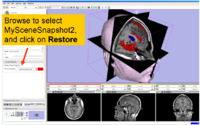
|
| 1.2 | Manual segmentation with 3D Slicer | 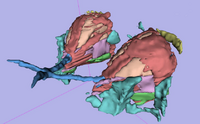
| |
| 2.2 | Image Guided Therapy Planning Tutorial This tutorial takes the trainee through a complete workup for neurosurgical patient specific mapping.See pages 58 to 80 of this tutorial on using the "Simple region growing" segmentation module.
|
Neurosurgical Planning Tutorial Data (.zip) | 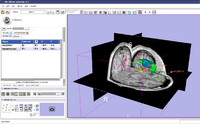
|
| 3.1 | Slicer3 as a research tool for image guided therapy research (IGT)
This tutorial is intended for engineers and scientists who want to use Slicer 3 for IGT research. |
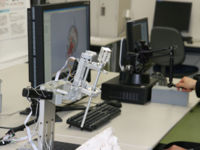
| |
| 3.2 | SPL-PNL Brain Atlas Tutorial
This three-dimensional brain atlas dataset, derived from a volumetric, whole-head MRI scan, contains the original MRI-scan, a complete set of label maps, three-dimensional reconstructions (200+ structures) and a tutorial. |
SPL-PNL Brain Atlas | 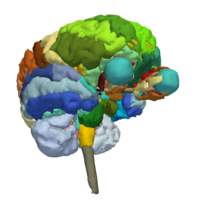
|
| 3.3 | SPL Abdominal Atlas Tutorial
This three-dimensional abdominal atlas was derived from a computed tomography (CT) scan, using semi-automated image segmentation and three-dimensional reconstruction techniques. The dataset contains the original CT scan, detailed label maps, three-dimensional reconstructions and a tutorial.
|
SPL Abdominal Atlas | 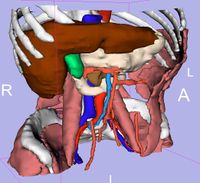
|
| 3.4 | Using XNAT Desktop and Slicer3 for remote data handling
This tutorial is intended for researchers who wish to upload local datasets to a remote XNAT repository like XNAT Central and retrieve catalog files that can be opened inside Slicer. |
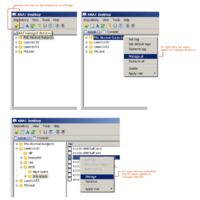
| |
| 3.5 | Harnessing Grid Computational Resources and integration with Slicer through the Grid Wizard Enterprise system
These tutorials are intended for researchers who wish to utilize distributed computational resources. |
Grid Wizard Enterprise | 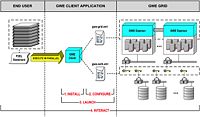 Featured Study Case (YouTube) |
- Category 1 = Basic functionality
- Category 2 = Advanced functionality
- Category 3 = Specialized application packages
Additional Materials
For a variety of data sets for downloading, check the following link.
